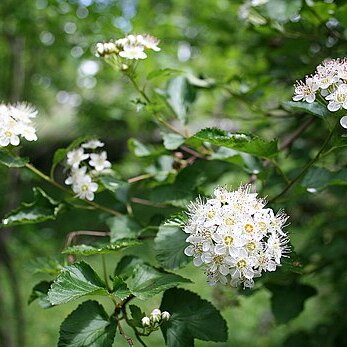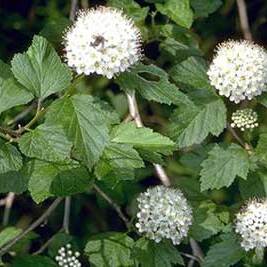Shrubs, (10–)30–60 dm, glabrous or stellate-hairy, mostly eglandular (except in inflorescence). Stems 5–20, ascending to erect, ?branches erect proximally, somewhat sinuous?; bark buff to reddish brown or black, ?usually peeling in narrow strips?; short shoots present; ?buds superposed, each with ca. 5 exposed brown scales?. Leaves deciduous, cauline; stipules caducous, ?decurrent on stem, leaving oblique, broadly ovate to rectangular stubs?, linear or oblong to narrowly ovate, obovate, or elliptic, sometimes rhombic, margins sometimes remotely glandular-dentate, ?surfaces sparsely stellate-hairy (glabrous adaxially in P. monogynus)?; petiole present; blade broadly ovate to obovate or orbiculate, 0.5–10 cm, membranous, margins flat, crenate to doubly crenate or doubly dentate, 3–5(–7)-lobed, rarely almost unlobed, ?3–5(–7)-veined?, surfaces glabrous or sparsely to densely stellate-hairy. Inflorescences terminal or axillary ?on leafy short shoots?, 5–50-flowered, open to dense corymb-or umbel-like pedunculate racemes; bracts present; bracteoles absent. Pedicels present. Flowers 5–12 mm diam.; hypanthium cup-shaped to campanulate, 1.5–3 mm, exterior stellate-hairy; sepals 5, ascending to slightly reflexed, triangular to ovate; petals 5, white to pale pink, broadly obovate, elliptic, or orbiculate, ?base short-clawed, sometimes irregularly toothed or notched?; stamens 20–40, shorter than, equal to, or exceeding petals; carpels 1–5; ?styles slender, stigmas capitate?; ovules 2–5. Fruits aggregated follicles, sometimes solitary, 1–5, ovoid, often ± inflated, slightly flattened, size not recorded, splitting along both sutures; hypanthium persistent; sepals persistent, ascending to slightly reflexed. Seeds 1(–5), ?shiny yellow, carunculate?. x = 9.
More
Shrubs deciduous. Branches spreading; buds small, with several alternate, exposed scales. Leaves alternate; stipules caducous; leaf blade usually 3-veined, margin usually 3-lobed, serrate. Inflorescence a terminal corymb. Flowers bisexual. Hypanthium cupular. Sepals 5, valvate. Petals 5, white or pinkish, slightly longer than sepals. Stamens 20–40. Carpels 1–5, connate at base; ovary 1-loculed. Follicles inflated, dehiscent along both sutures. Seeds 2–5.
Hypanthium shallowly cupulate; sep 5, triangular, persistent; pet 5, suborbicular, spreading; stamens 20–40; pistils (1–)3–5, sometimes weakly united below; style elongate; stigma capitate; ovules few; fr a firm-walled inflated follicle, dehiscent on both sutures; seeds hard, shining, with endosperm; shrubs with stipulate, simple, usually lobed lvs and corymbose white fls. 10+, N. Amer., Asia.


